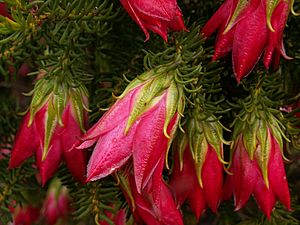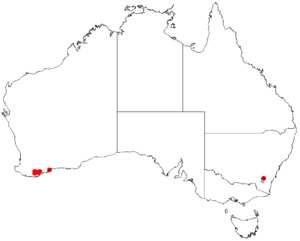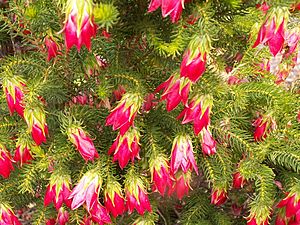Gillham's bell facts for kids
Quick facts for kids Gillham's bell |
|
|---|---|
 |
|
| D. oxylepis in Cranbrook wildflower garden, Cranbrook, Western Australia. | |
| Conservation status | |
| Scientific classification | |
| Genus: |
Darwinia
|
| Species: |
oxylepis
|
 |
|
| Occurrence data from AVH | |
| Synonyms | |
|
|
Gillham's bell (scientific name: Darwinia oxylepis) is a special plant from the myrtle family. It grows as a thick, upright bush, usually about 1 to 1.5 metres (3 to 5 feet) tall. In spring, it produces many bright red flowers that look like bells. These flowers grow at the ends of its branches.
Gillham's bell is part of a group of plants called "mountain bells." Other plants in this group include D. leiostyla and D. macrostegia. You can only find Gillham's bell in a few wet valleys near the Stirling Range National Park and Porongurup National Park in Western Australia. Because it's so rare, it is considered an endangered plant.
Contents
What Does Gillham's Bell Look Like?
Gillham's bell is a small, bushy plant that stands upright. It can grow up to about 1.5 metres (5 feet) high. Its branches grow straight up, and it has short twigs.
The leaves of Gillham's bell are about 10 millimetres (0.4 inches) long and 1 millimetre (0.04 inches) wide. They are almost round or triangular when you look at them closely.
The plant's bell-shaped flowers appear from August to November. These are actually clusters of about 10 flowers that hang downwards. They are full of nectar, which is a sweet liquid. Bright red, petal-like leaves called bracts surround these flower clusters. These bracts can be up to 30 millimetres (1.2 inches) long.
Naming Gillham's Bell
Darwinia oxylepis is one of about 70 types of Darwinia plants. Most of these plants are found only in Australia, especially in southern Western Australia.
This plant was first described in 1852 by a scientist named Nikolai Turczaninow. He gave it the name Genetyllis lejostyla. Later, in 1980, two scientists, Neville Marchant and Greg Keighery, gave it its current name, Darwinia oxylepis.
The second part of its scientific name, oxylepis, comes from two ancient Greek words. Oxys means "sharp," and lepis means "flake" or "scale." This name refers to the sharp shape of the red bracts that surround the flowers.
Where Gillham's Bell Grows
This special Darwinia plant grows in rocky valleys that get very wet in winter. The soil there is stony and peaty (like mossy soil).
There are only four known groups of D. oxylepis plants. All of them are found inside national parks: the Stirling Range and Porongurup National Parks.
These plants face several dangers:
- They are very sensitive to a fungus called Phytophthora cinnamomi, which can make them sick.
- The areas where they grow are also prone to bushfires.
- Bushfires kill the plants, but new ones can grow from seeds hidden in the soil. However, it takes about four years for new plants to produce their own seeds. If fires happen too often, the plants might not have enough time to regrow, which could make them disappear.
- Tourists often visit these areas. The plants are at risk from people accidentally stepping on them or picking parts of the plant without permission.
Protecting Gillham's Bell
Because Gillham's bell is so rare and faces many threats, it is listed as "endangered" by the Australian Government. This means it is protected by law under the Environment Protection and Biodiversity Conservation Act 1999.
It is also classified as "Threatened Flora" by the Department of Environment and Conservation in Western Australia. Plans are in place to help protect and recover this plant.
In October 2000, about 4,000 Gillham's bell plants were counted. But after a large bushfire later that month, almost all of them were gone. This shows how fragile these plants are.
How Gillham's Bell Reproduces
It can be tricky to grow Gillham's bell in gardens. It's hard to grow new plants from seeds. However, it's easier to grow them from cuttings (small pieces of the plant). Even then, they often don't live very long in a garden.
A better way to grow Gillham's bell is by grafting it onto another, tougher Darwinia plant from eastern Australia, like the D. citriodora. This method helps the plant survive better.



